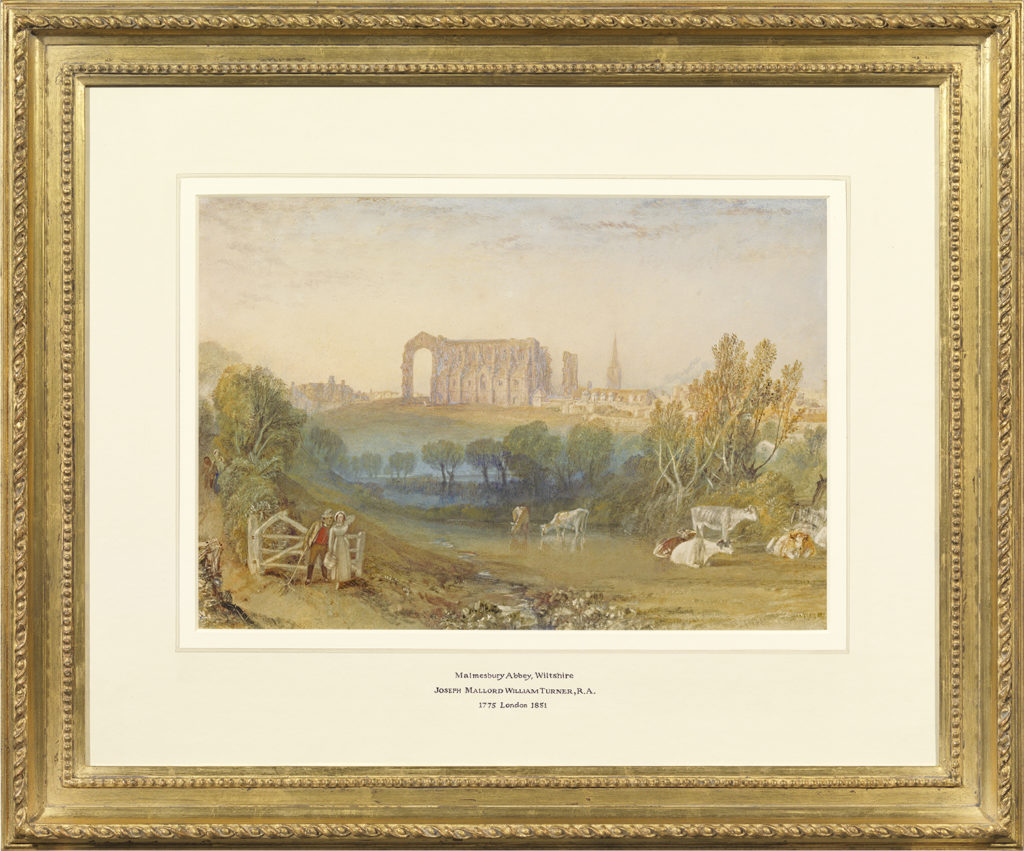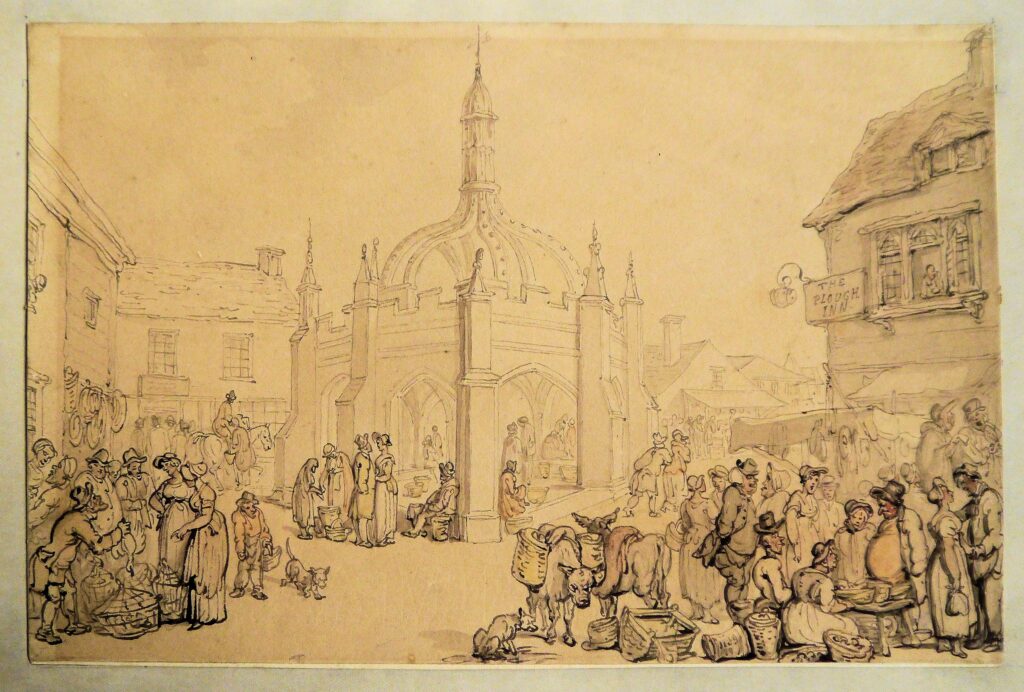We are lucky, Malmesbury is such a beautiful place that artists have been drawn here. In the late eighteenth century picturesque ruins were the ‘in’ thing. J M W Turner and Thomas Girtin came here together in 1791 and again in 1797. Two and a half centuries earlier Leland in his travels around England as the King’s Antiquary visited Malmesbury and painted vivid word images of what he saw. John Betjeman, the twentieth century poet enthused over the town.
This page contains some of the museum’s works of art that date from before 1940.
Later works can be found on our “Post-1940 Art” page.
Many images of Malmesbury, e.g. etchings, and photographs can also be found on our “Malmesbury Images” page.
The majority of these works are not normally on display in the museum, the notable exception is our Turner watercolour. If you wish to see any of the others please contact the museum via email at info@athelstanmuseum.org.uk.
The museum collection has been built over about 80 years of kind donations without which open access to these works would not be possible. We would particularly like to thank the late Richard Hatchwell who bequeathed his significant collection of Malmesbury related images to the museum.
Please click on any image to see a larger version of it.
Watercolour by J.M.W. Turner
The artist simply known the world over as ‘Turner’ needs no introduction. He is widely regarded as one of the most talented artists this country has produced. His connection to Malmesbury is not so widely known but in fact he visited the town three times, first in 1791 aged just 16, and made several sketches of the Abbey and its setting above the Avon.
Developed from Turner’s early sketches and painted in about 1827, our watercolour is one of the 96 which make up Turner’s set of ‘Picturesque Views in England and Wales‘ (1825-38). These views have long been celebrated as the finest of Turner’s topographical projects and noted examples of the picturesque movement. The England and Wales series embraced a diverse range of subjects from contemporary to more nostalgic subjects, recorded many years earlier. This view of Malmesbury Abbey falls into this latter category, representing a setting Turner had known since his adolescence, but enriched, when painted, with over thirty years’ experience. It is believed that this is the only finished watercolour of this aspect of Malmesbury Abbey.
Read more…
Thanks to significant grant funding from the National Lottery Heritage Fund and the Art Fund, in 2020 the Athelstan Museum was able to purchase this fine watercolour of Malmesbury Abbey by Joseph Mallord William Turner.
This picture enhances the museum’s existing collection of Malmesbury related art; including works by Thomas Hearne who influenced Turner himself. A rotating exhibition accompanies the Turner watercolour in the Athelstan Museum’s mezzanine gallery. Critically this acquisition also offers opportunities for us to run programmes and events aimed at celebrating; and engaging more people with; the town’s rich heritage and culture.
The Museum has published a monograph to mark the acquisition of the painting; written by distinguished Turner historian Ian Warrell and lavishly illustrated with some of Turner’s early Malmesbury sketches and relevant works by other artists. This is available to purchase in the Museum shop and online. See our Shop page.
The museum was honoured that HRH the Prince of Wales, patron of the Turner Society, recorded an introduction for our series of talks about Turner. You can watch this here.
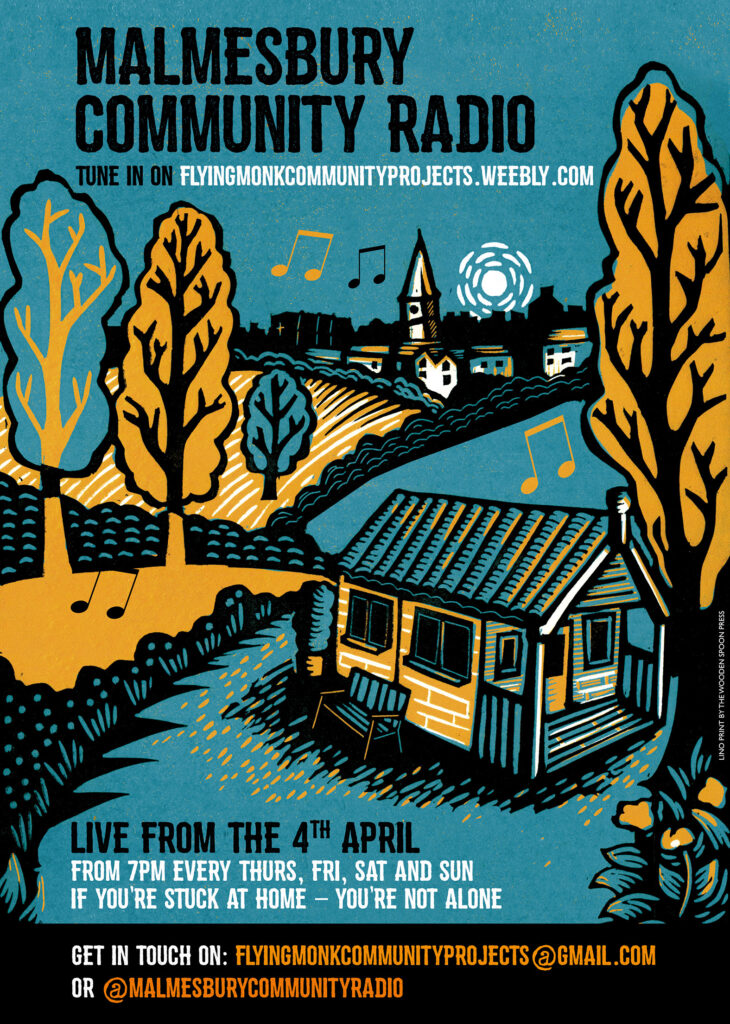
Here you can listen to an interview with museum volunteer Sue Poolman, telling the story of the Turner and its acquisition by the museum.
There was a virtual opening of the Turner display. To view a short film of the opening use the controls at the bottom of the image to the left.
Art students from Malmesbury school took part in a project to produce paintings of Malmesbury Abbey which were put on show in the Rausing Building in June 2023. There were six paintings by pupils chosen to hang beside the Turner painting in the museum. Pictures of these pupils at the Museum were taken.
Pencil drawing by Tom Girtin of Malmesbury Market Cross.
This is a pencil drawing by Tom Girtin of Malmesbury Market Cross. It is drawn from Gloucester Street looking eastwards and shows as well as the Market Cross the projecting fronts of the houses on the south side of Gloucester Street. Girtin visited Malmesbury twice, in 1791 and 1797.
The drawing was purchased by FOAM in 1982 with the assistance of the Victoria and Albert Museum, the Beecroft Bequest and North Wiltshire District Council and Malmesbury Town Council.
Market Day at Malmesbury Market Cross by Thomas Rowlandson
In 2021 the museum acquired a pen, ink and watercolour drawing of market day at the Market Cross, by Thomas Rowlandson (1757-1827). This work probably dates from 1805-1815.
This is a typically crowded and busy scene from the popular Georgian artist and caricaturist, contemporary of James Gillray and, like him, noted for his political satire and social observation.
Rowlandson worked extensively in the West Country where he made annual tours.
The museum’s drawing is probably a result of Rowlandson common practice of making several copies of the same composition. This enabled him to meet the demand for his work which was very popular during his lifetime. A more ‘finished’ and less faded version of this same image is known.
Although our drawing is small (15.4 x 23.5 cms) it is packed with character and incident and repays close examination!
Drawings by Luke Sullivan
The museum has four drawings by Luke Sullivan. Sullivan was an engraver and artist
who was born in Louth, Ireland, in 1705 and died in April 1771. The four pictures in the museum’s collection are belived to be graphite drawings. Two of the drawings are of Malmesbury Abbey, and the other two are rural scenes.
Sullivan initially trained in Paris with an engraver named Thomas Major and later moved to London where he engraved several works by William Hogarth. He later engraved original works, notably the homes of the aristocracy.
He also became famous for painting miniature portraits in watercolour on ivory. Sullivan exhibited with the Society of Artists from 1764-70, where Horace Walpole in Graves’ Dictionary of Artists mentioned his work was exceedingly fine, and the artist J. T. Smith states that Luke Sullivan was “the most extraordinary of all miniature painters”.
There are some other examples of his graphite drawings similar to the ones that the museum possesses, but little is known about the artist’s life or when he might have drawn these.
Pictures of the Abbey by Thomas Hearne
Thomas Hearne (1744 – 1817) was an English landscape painter, engraver and illustrator who spent his early years living in Brinkworth, near Malmesbury.
Thomas was apprenticed to his uncle, a pastry-cook in Covent Garden, London, whose premises were next door to an engraver’s print shop. By 1765 he was apprenticed to the engraver William Woollett, with whom Thomas remained for six years. In 1771 Hearne, together with the art patron Sir George Beaumont, were staying with Beaumont’s tutor, Revd Charles Davy in Suffolk and later that year travelled to the Leeward Islands with the governor-general Sir Ralph Payne where he remained for three years. Whilst there he changed the focus of his art from engraving to drawing in water-colours.
In 1777, in conjunction with engraver William Byrne, Hearne began work recording and illustrating the country’s historic monuments for ‘The Antiquities of Great Britain’, (fifty two etchings). Whilst travelling the country producing these etchings Hearne also produced watercolours which expressed light and atmosphere seldom achieved by previous draughtsmen in this medium. He may thus be said to have done much to revive interest in Gothic architecture, and to have been one of the founders of the English school of watercolours. His art had much influence on Girtin and Turner. From 1781 to 1802 he exhibited drawings of landscape and antiquarian remains at the Royal Academy.
The museum also has these etchings of Malmesbury by Hearne…
Other Images
Please click on any image to see a larger version and more information.
Amongst the many other paintings in the museum’s collection we also have this group of rather characterful oil paintings, thought to be from the 19th century, but we have no further information about them.

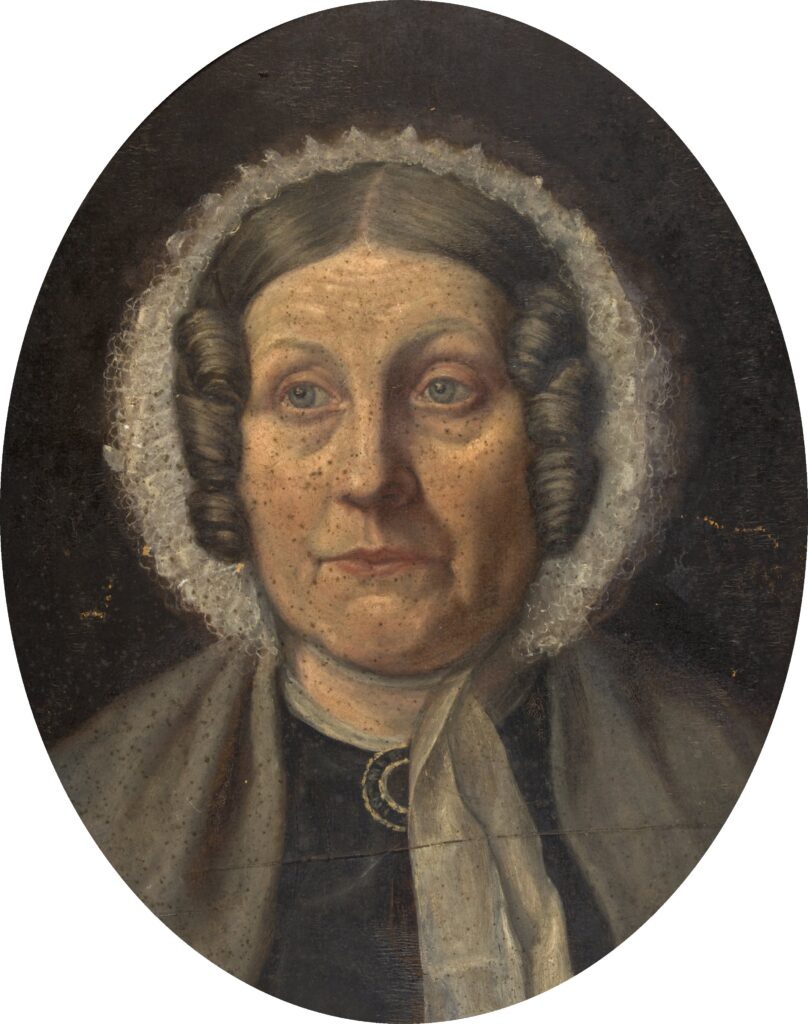

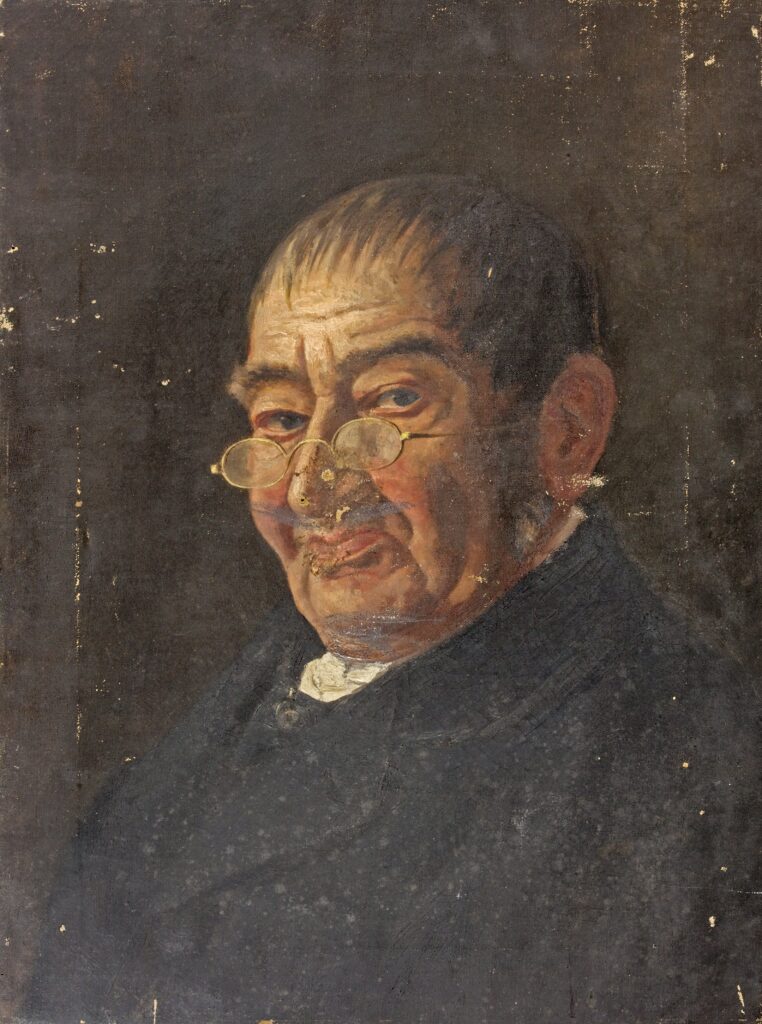
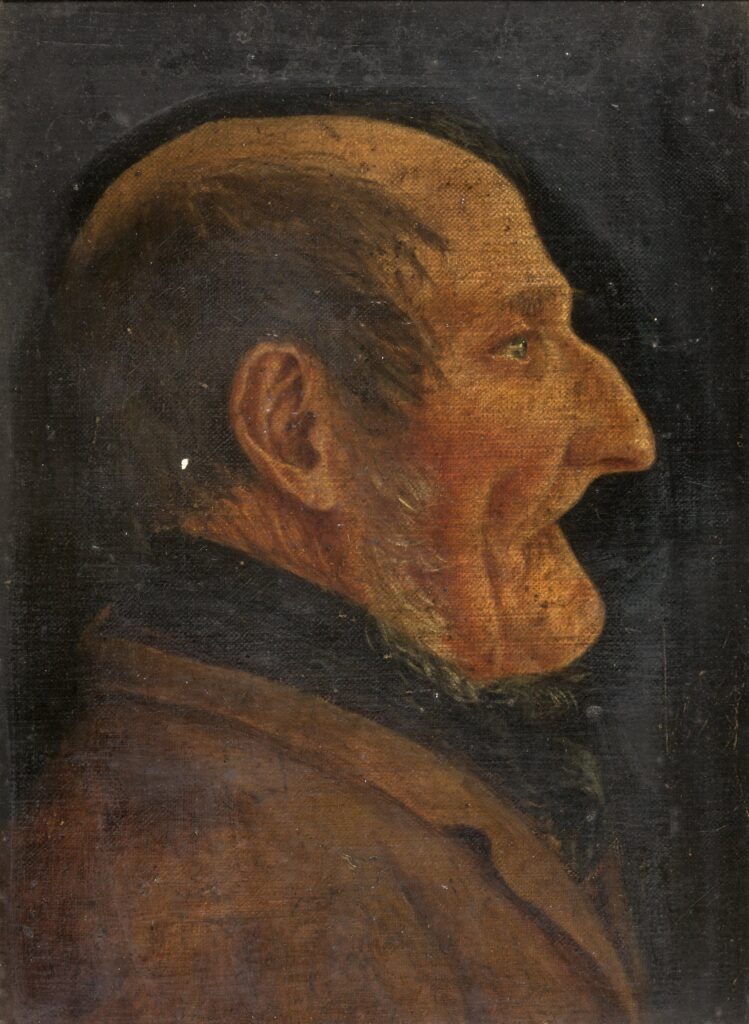

J.Coney
Here are two of the pictures that we have by the artist J. Coney:

A pencil drawing of the Abbey from the SW. 1817.
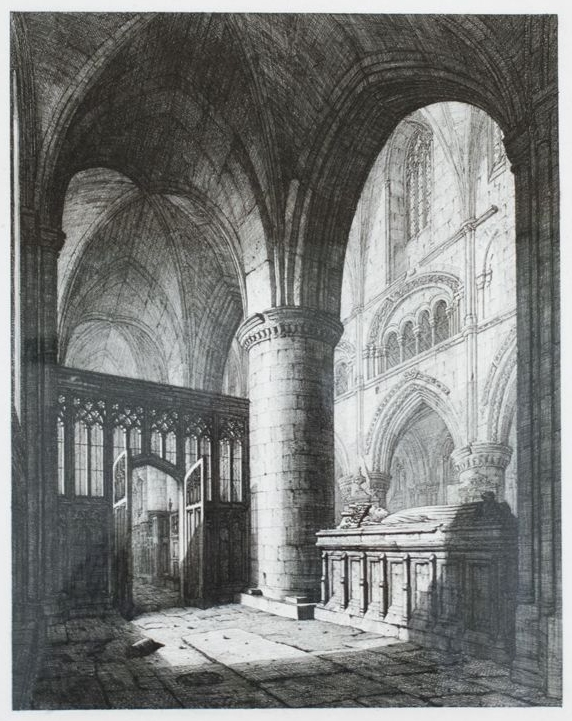
An etching showing of the SW interior of the Abbey in 1817, with Athelstan’s tomb in it’s previous location. Probably by John Coney an architectural draughtsman and engraver who was born in London in 1786, and died there in 1833.
He specialised in detailed drawings of ecclesiastical and other public buildings, which he then engraved himself; eg, for the books Monasticon (English abbeys and cathedrals), and Architectural Beauties of Continental Europe.
His work is held in many museums and galleries including the V&A, British Museum , the University of Michigan Museum of Art and the Fine Arts Museums of San Francisco.
E. Dorrell
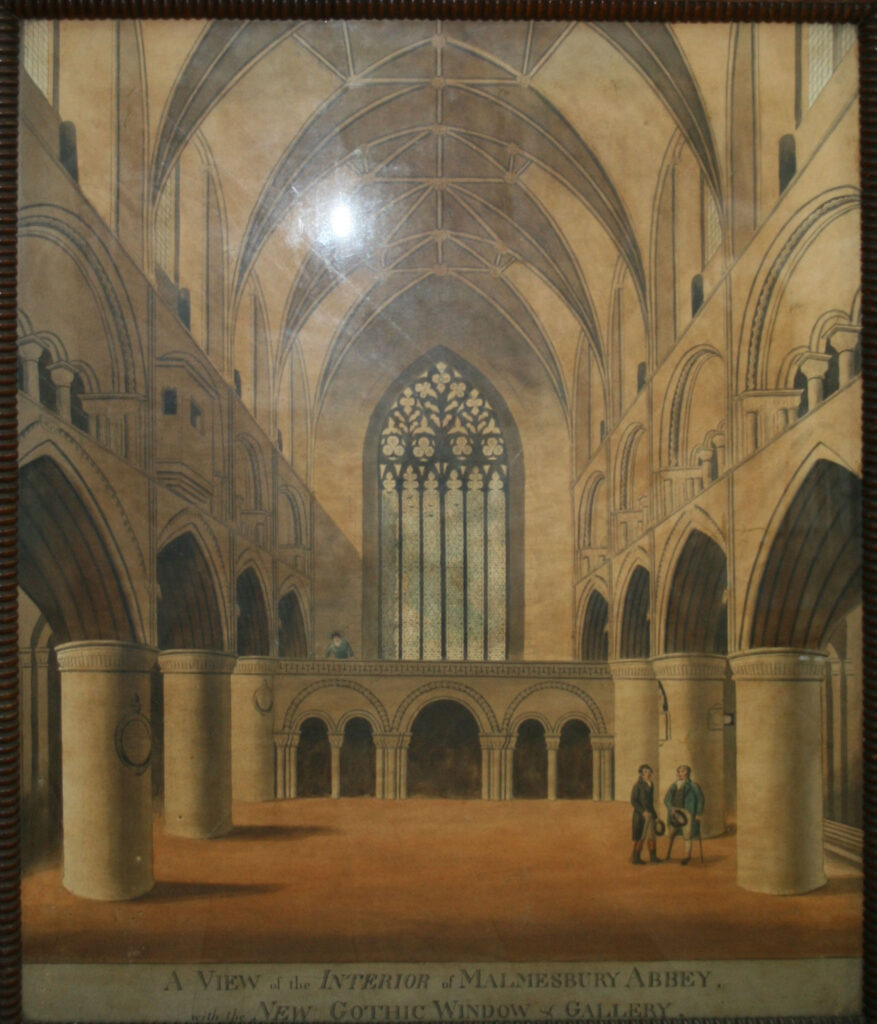
A watercolour of the west end of the Abbey, probably by Edmund Dorrell 1778 – 1857. Watercolour artist and a student at the Royal Academy Schools from 1797, the V&A holds one of his paintings. The few images of his pictures we know of are landscapes rather than interiors but the timings are right and ours is a watercolour.
It is interesting to note that the west window was “new” at this time.
Oliver Hall
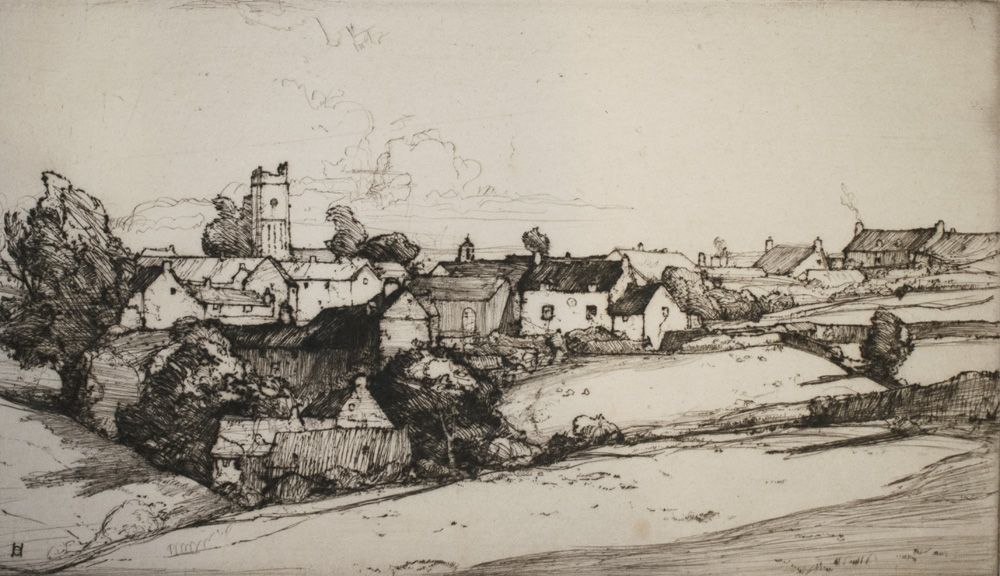
Drawing of Sherston by Oliver Hall RA 1869 – 1957
Hall was born in London and studied at the Royal College of Art. He travelled extensively on the continent. First exhibited at the RA in 1898 and then widely in London. He became a senior Academician in 1945. Died in Ulverston, Lancashire. His works are held in many public collections including the British Museum and the Tate.
J. Muller
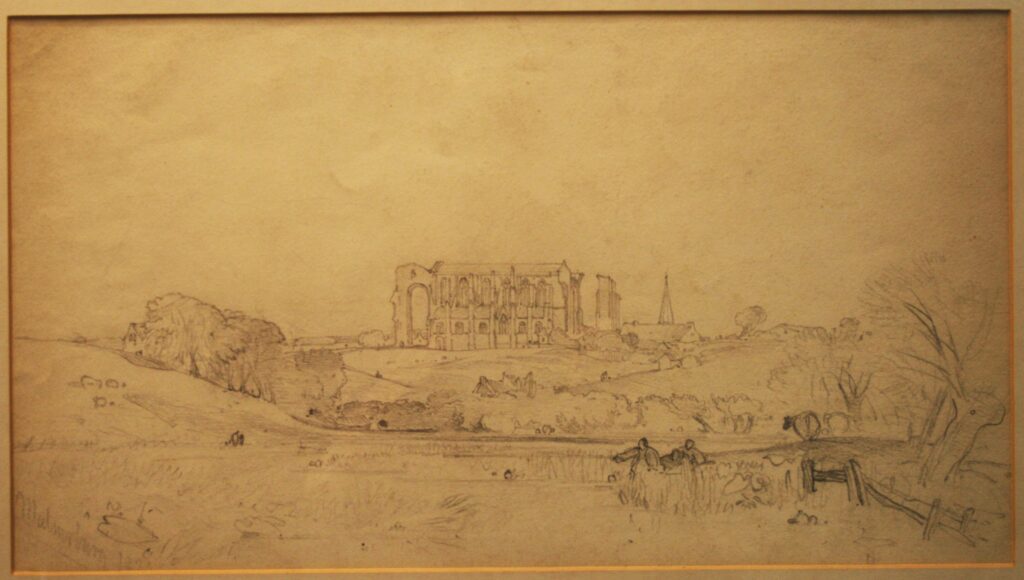
A view of the Abbey from the north, probably by William James Muller 1812 – 1845.
A member of the Bristol School of artists he was a landscape and figure painter who travelled widely, including to Egypt and Turkey, sketching and painting and often exhibited, including at the Royal Academy.
Dr. Munro
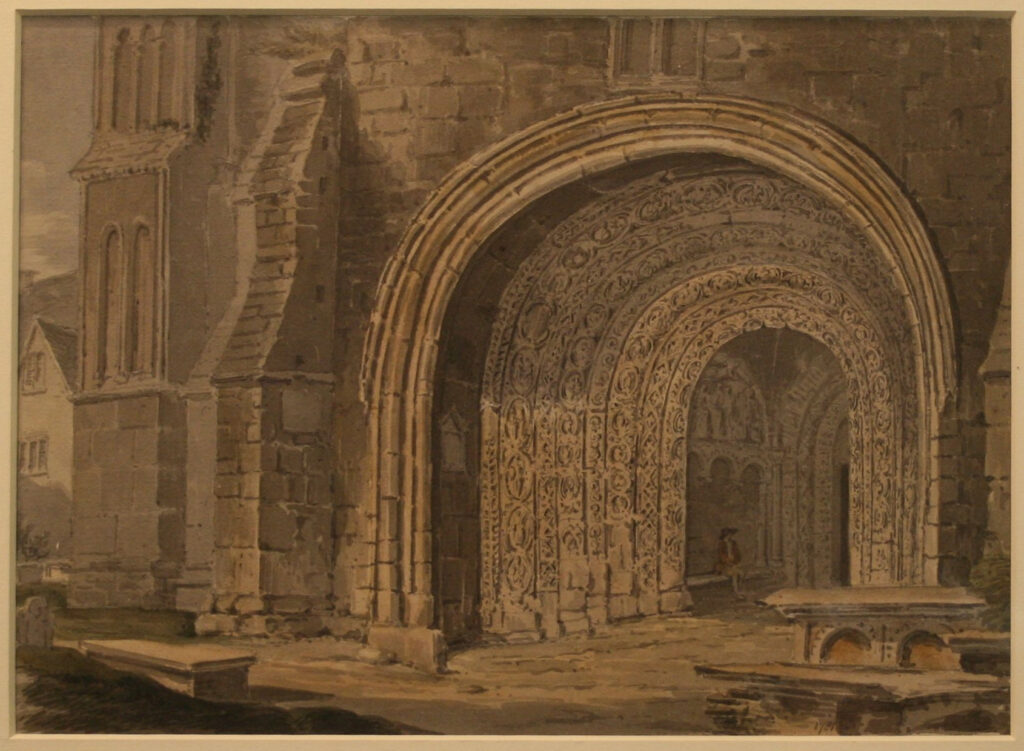
A view of the south porch by Thomas Monro, 1759 – 1833, art collector and patron.
He was Principal Physician at the Bethlem Royal Hospital and one time consulting physician to George III. He was a patron to JMW Turner as well as to Tom Girtin and Thomas Hearne, works by whom we also hold in the museum collection
W.H. Pyne
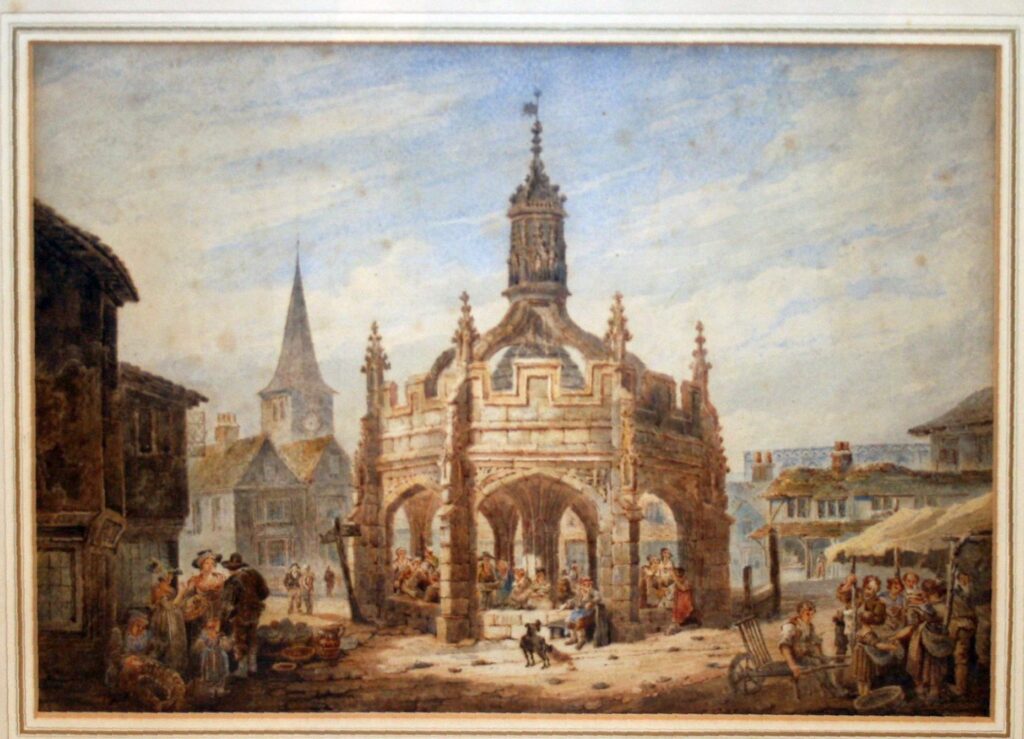
A watercolour of the Market Cross, probably by William Henry Pyne 1769 – 1843, writer illustrator and painter. Born and died in London. He first exhibited at the Royal Academy in 1790.
He specialised in picturesque settings including groups of people in ink and watercolour.
Greta Ward
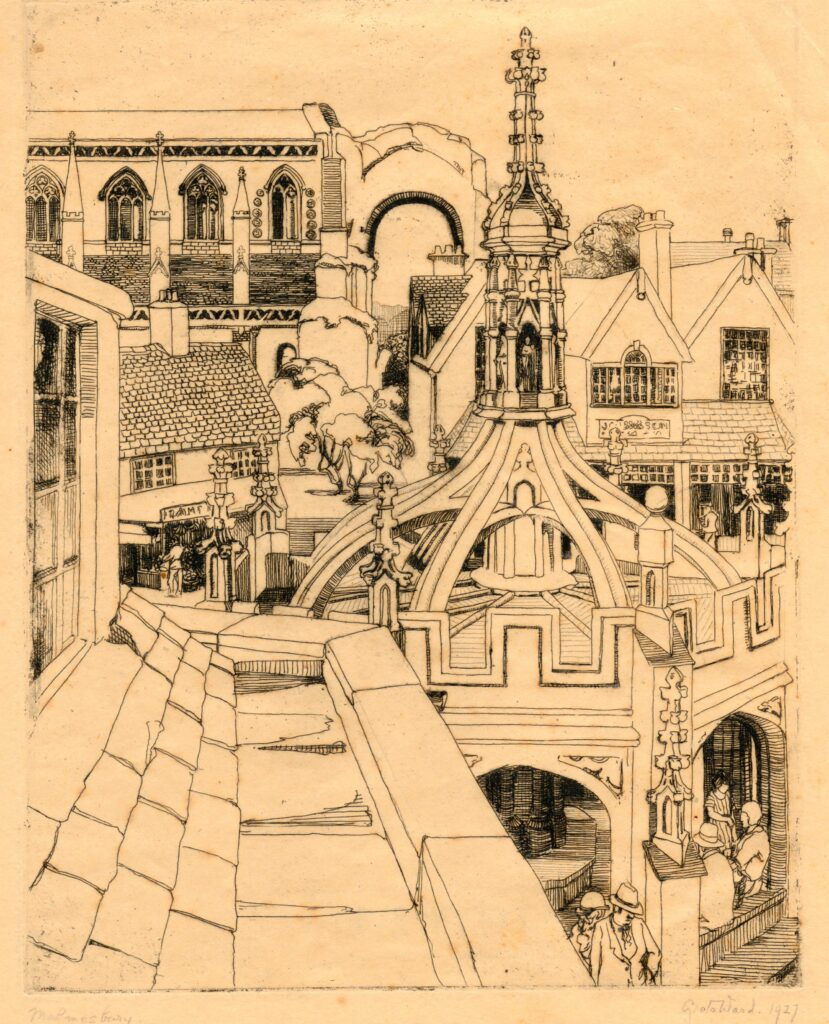
An etching of the Market Cross with Abbey beyond, 1927.
Gertrude Mary Ward, sometimes known as known as Greta, was born in Malmesbury in 1902. Her father was Arthur Ward who was minister at the Moravian church from 1894 to 1904 and was an authority on Moravian Missions and it was during this period that the stained glass windows were installed in the church (now the Julia & Hans Rausing Building).
After just a few years the family moved away, to Bath in 1911, and latterly to North London. It was here that she married a fellow artist Archibald Sanderson in 1936. In the General Register of 1939 they are listed as school master and helper with evacuees in Diss (Norfolk). Greta returned to Enfield after WWII, living there until her death in 1981.
Greta and Archibald both painted bucolic landscapes of southern England and worked in a graphic style that was influenced by wood engraving of the period, such as the work of Eric Ravilious and Robin Tanner. They both exhibited at the Royal Academy, the New English Art Club and elsewhere.
It is said that an etching was gifted to her by printmaker Robin Tanner (1904–1988) and this seems to indicate a long lasting connection to the town, considering the young age at which Greta moved away.
W.W. Wheatley
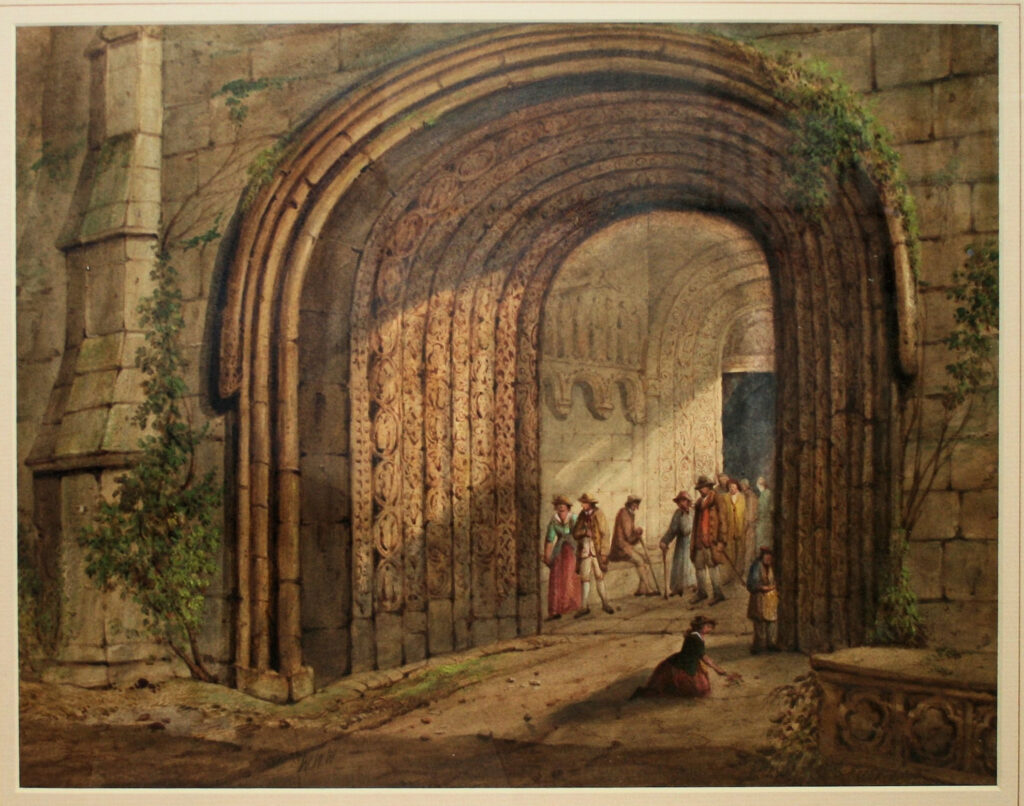
This watercolour of the south porch is probably by William Walter Wheatley 1811-1885.
Wheatley was born in Bristol and lived and worked in this area. He was a sketcher and watercolour artist, particularly of churches but Bristol Museum also holds painting by him of Bristol riots.
Anonymous

This anonymous watercolour is of the Abbey west end, c.1800.
Anonymous
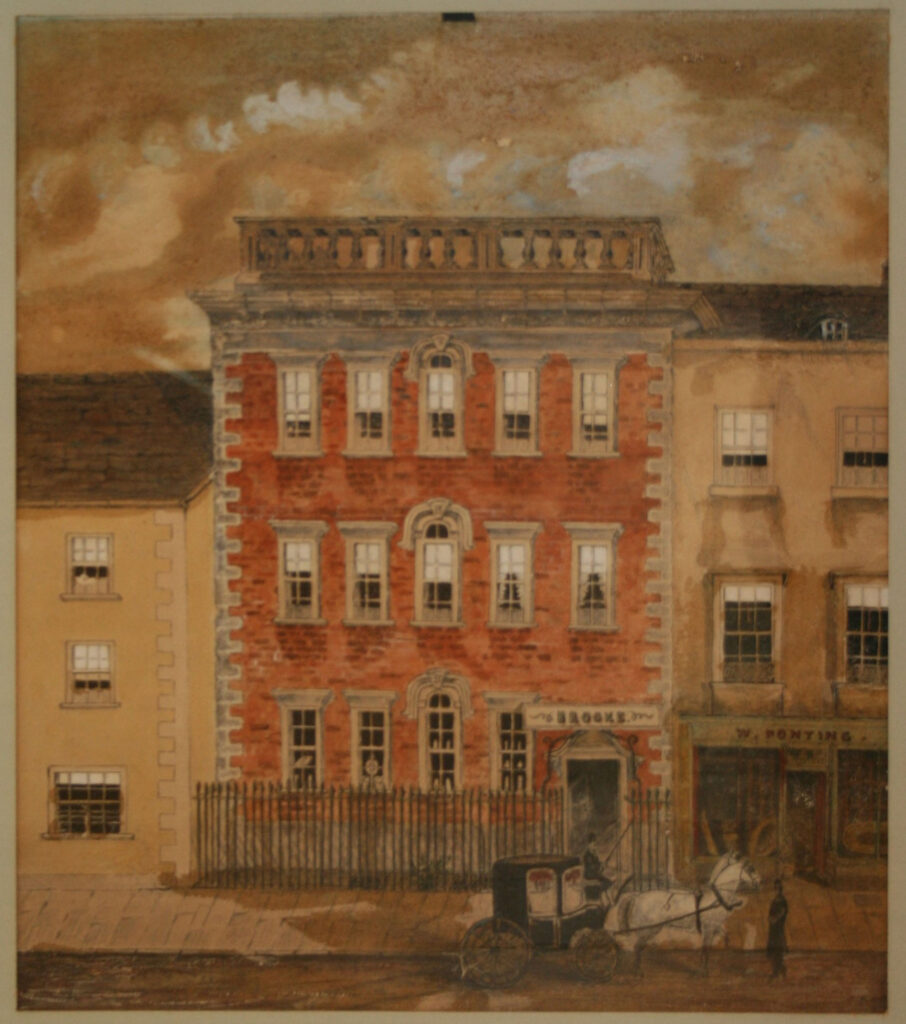
This anonymous watercolour shows Malmesbury High Street premises in 1859. On the left is Pontings Ironmongers which has been E & S Ironmongers since 1948, and Brookes Bakers which became a bank, Malmesbury RDC offices and is now Castle Sundborn, financial services.




